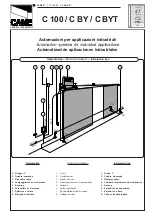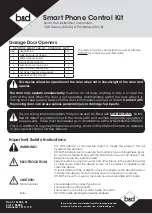
EN
INSTRUCTIONS FOR INSTALLATION AND USE
DUEVILLE
41
IT
USE AND OPERATION
5
5.1
TECHNICAL DESCRIPTION
The power supply is 230V~ 50/60 Hz with low voltage transformer 22V AC ~ 150 VA.
The main section bar/crossbar of the automation is made of high resistance anodized extruded aluminum. The gearmotor,
toothed belt and electronic control circuit are incorporated in a covered casing in anodized extruded aluminum, fastened by
fitting for more rapid, simple access in case of maintenance.
The movement, position and speed of the door are managed by the electronic control circuit via a reading device and optical
encoder installed on belt transmission.
The automation is electromechanical, without clutch or brakes, to prevent possible blockage of a continuous nature due to
damages or breakage of the structure.
Safety anti-crushing device on both closure and opening, that enables the door to reverse its movement if it meets an
obstacle.
The carriages supporting the door are made of sheet steel, and are equipped with high-density plastic wheels with lifetime
lubrication of the bearings, on a rail inside the main section bar/crossbar. The transmission and movement via gearmotor
function at 24V 45W on a wormscrew with lifetime lubrication and a toothed belt in anti-static rubber material with steel cable
strands that are long-lasting and wear-resistant.
The electronic control circuit is a microprocessor type with keys for adjustment of the parameters such as speed of opening
and closure, slowing space, low approach speed, automatic reclosing time and mode of operation.
5.2
EMERGENCY BATTERY
5.3
FIRST CARD START-UP
9) Charge the battery for 24 hours.
Door operation in emergency case:
The automation equipped with an emergency battery, will perform, in case of
power failure, the “default battery operation mode”: the “continuous operation mode” and will continue to operate as set
as in the selector program. The "battery operation mode" can be changed in other modes, using the Topp DS2 digital
program switch. Emergency opening or closing can be set. In the case has been selected a different mode operation
than the standard one, the automation will resume to function as the program set by the selector after restoring the 230V
mains.
In the event that the battery is fully discharged, the time required to fully recharge it is
10 hours
.
1) Switch on automation / electronic unit;
2) Enter the programming function, see Chap.5.6 Programming parameters;
Supervision and automatic testing of the emergency battery:
The emergency battery function is kept under constant
control by the electronic microprocessor control circuit. This supervision and test constantly verifies the efficiency of the
battery that, in case of malfunction, blocks the door and thereby signals the malfunction. Emergency opening or closure
depends on the function entered in the program setting of the electronic circuit board.
7) Connect the wire to the emergency battery again;
Emergency battery performance:
To ensure the maximum performance of the emergency batteries and prevent their
deterioration, the batteries should be recharged every 3 months in case of disuse or for products in storage.
5) Disconnect the emergency battery wire;
Contact a qualified technician in the event that the battery requires replacement;
4) Exit the programming function. Disconnect power to the automation/electronic unit from the 230V mains (see Chap.4.4
Electrical connections);
8) Plug into the 230V mains;
Manual emergency opening:
When it is required that the emergency opening not be performed automatically in case of
power outage on the 230V mains, it is possible to install a key for management of this function.
When the key is installed, the emergency battery will not act in case of power outage, until the key is pressed.
To recharge the battery, proceed as follows:
3) Set “parameter 5: Emergency battery”, without a dot (no dot after the 5 on the display);
6) Switch off the automation / electronic unit;
The first start-up function serves to return the card to the original factory settings.
Ÿ
At this point, the card will wait to be reset (
see para. 5.4
).
Ÿ
Remove 230V power and disconnect the battery from the circuit board;
This procedure will delete all the previous settings, except:
Ÿ
Error history; Counters; Cycles and expiry dates of the maintenance menù.
Instructions for performing this procedure:
Ÿ
Simultaneously press the two buttons "ENTER" and "DOWN" on the electronic board (
see Figure 8
);
Ÿ
Connect the battery 24V and return power to the circuit board 230 by continuing to hold the two keys "ENTER" and
"DOWN";
Ÿ
After 4 seconds, the card is placed in the "FIRST START" and the 7-segment display the letter "A" flashing.
Summary of Contents for DUEVILLE
Page 2: ......
Page 52: ...52 EN INSTRUCTIONS FOR INSTALLATION AND USE DUEVILLE ...
Page 53: ...EN INSTRUCTIONS FOR INSTALLATION AND USE DUEVILLE 53 ...
Page 54: ...54 EN INSTRUCTIONS FOR INSTALLATION AND USE DUEVILLE ...
Page 55: ...EN INSTRUCTIONS FOR INSTALLATION AND USE DUEVILLE 55 ...
Page 56: ...56 EN INSTRUCTIONS FOR INSTALLATION AND USE DUEVILLE ...
Page 57: ...EN INSTRUCTIONS FOR INSTALLATION AND USE DUEVILLE 57 ...
Page 58: ...58 EN INSTRUCTIONS FOR INSTALLATION AND USE DUEVILLE ...
Page 59: ...EN INSTRUCTIONS FOR INSTALLATION AND USE DUEVILLE 59 ...
















































